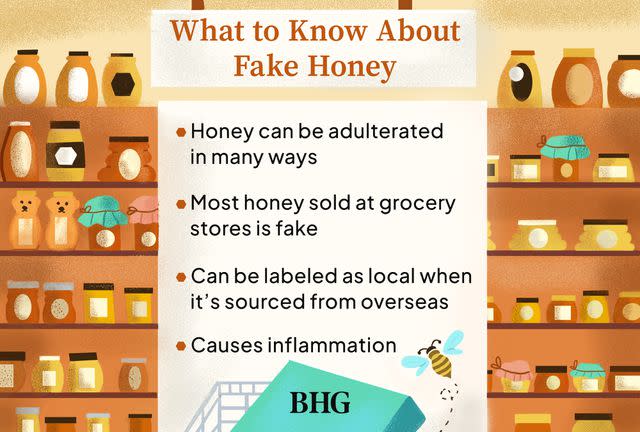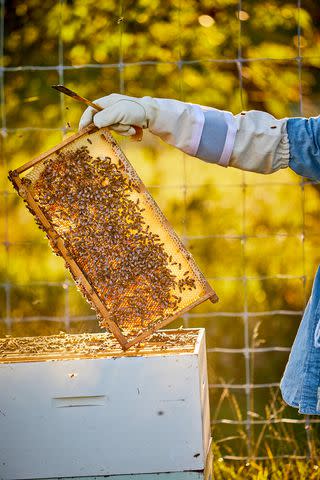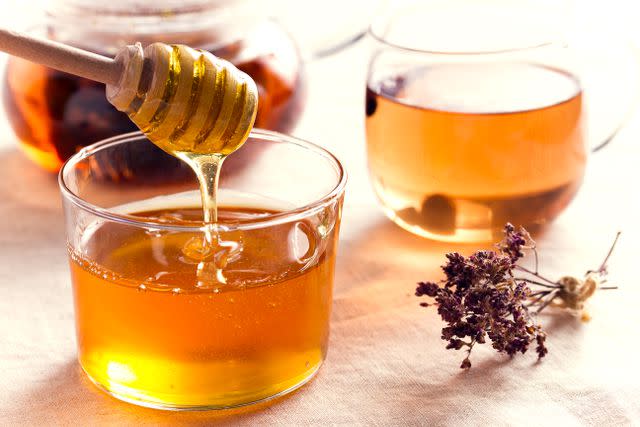Is Your Honey Actually Honey? Here's How to Tell if It's Fake
Fraudulent honey is incredibly widespread—here's how to tell the difference and why it matters.
You probably weren't aware that much of the honey found on grocery store shelves is actually fake—in some cases, it contains little to no actual honey. In fact, honey is one of the most faked foods found in our food supply today. Here's why, and how it's affecting those who produce real honey—plus what it means for all the supposed health benefits of the so-called superfood.

BHG / Sydney Saporito
Related: The Superfoods Everyone Will Be Putting on Their Grocery Lists in 2023
What is Fake Honey?
Humans have been consuming honey for thousands of years, but it's truly all the rage right now— over 562 million pounds were consumed in 2022 alone, and demand dropped only slightly last year from 2021's record high. The flavor and health benefits both earn it a spot in an increasing number of products as the years go on. But most consumers are unaware that much of the honey they’re consuming isn’t actually honey at all.
Honey can be adulterated in many ways—from treating it with heat to filtering it to diluting it with modified additives like sugar or syrup. It can be harvested too early as plant nectar, doctored up, and sold falsely as the end product, honey. It can even be labeled as local when it’s really sourced internationally. Other particularly savvy honey-making imposters go as far as to feed bees sugar and syrup to produce honey, rather than natural foraging—severely impacting the product’s nutritional benefits. And even the higher-end honeys like Manuka aren't necessarily safe from these dodgy escapades.
How We Got Here
But how can this continue to happen? While the United States Department of Agriculture (USDA) has created a grading system for honey to let consumers know the quality of the product they’re buying, there is no enforcement system in place, so producers can put just about whatever they like on the bottle.
This calls back to the “honey laundering” schemes that made major headlines back in 2013, with the Homeland Security investigation called Project Honeygate. Two major honey importers, Honey Solutions and Groeb Farms, shipped fake honey to the U.S. from China by first sending it through Asian and European countries. Not only did this charade allow the importers to send fake honey into the U.S., but it scored the companies an additional $180 million in avoided shipping duties, making it the biggest food fraud incident in the country’s history.
Unfortunately, though that operation was discovered and shut down, not much has changed since that time, and the shady honey business still occurs today. Some experts estimate that up to 70% of all U.S. honey is fake or adulterated in some way.

The Impact of Fake Honey
As you might imagine, this sticky situation has sprawling impacts on bees and beekeepers—as well as the true nutritional benefits of honey.
It's Bad for Bees and Their Keepers
Bee populations across the country are already on the decline due to the loss of natural ecosystems to deforestation, infrastructure, residential development, and farmland. The widespread use of insecticides and pesticides in residential and agricultural environments, in addition to disease within bee populations, is also leading to bee population decline. In fact, between April 2020 and April 2021, U.S. beekeepers lost over 45% of their bee colonies. This is especially concerning because, honey aside, bees have another extremely important job to get done—they pollinate the plants we eat, playing a vital role in food production across the planet.
The fake honey problem is driving honey prices way down, which severely impacts beekeepers who are producing the real stuff. This makes it difficult for them to make a living off of honey production as they might have been able to in the past. It’s also causing them to put more pressure on their bees to collect even more nectar to produce increased quantities, possibly to the detriment of the other plants they would otherwise be pollinating. These practices often force bees to adapt to surviving off of a more homogenous diet, negatively impacting their overall health.
Because of how the honey landscape has shifted, beekeepers are increasingly turning to other sources of income as the profession becomes less and less sustainable. And, with fewer virtuous honey producers out there, the retail potential for fake honey producers becomes even greater.
Related: Beekeeping for Beginners: What You Need To Know To Start a Hive
Nutrition Suffers
In terms of nutrition, it's probably not a shock to find out that fake honey lacks many of the therapeutic benefits associated with the real thing. Real, raw honey is well known for being full of bioactive compounds with antibacterial and anti-inflammatory properties. It can also be protective of cardiovascular, gut, and respiratory health—and that's just the tip of the iceberg.
When we consume fake honey—made from refined sugar or high fructose corn syrup—we’re not only missing out on all of these therapeutic benefits, but we’re actually consuming a highly inflammatory food, essentially causing the opposite effect on our health. Also, if adulterated honey is treated with heat or filtered, many of the compounds that make honey so healthful can be lost.

Elizaveta Antropova / Getty Images
Steering Clear of the Fake Stuff
So, how can you ensure that you’re getting the nutritional benefits associated with real honey while also supporting the wellbeing of bees and beekeepers? While it can be tricky to know how to fully avoid the fake kinds, there are some ways to get a pretty solid answer on what's what.
The only ways to be absolutely certain that honey hasn’t been adulterated are to either check the chemical composition or check the product's true origin.
Support Your Local Beekeeper
Most of us don’t have expensive lab equipment lying around the house to check the composition of our honey, but many of us do have easy access to a local honey producer. By connecting with local beekeepers, we can stay informed while also supporting these crucial food producers. Beekeepers are working to support one of the most vital animals to our food supply's security and more than deserve our business and attention.
Look for Certifications
Otherwise, there are some traceability certification organizations that you can turn to, including True Source Honey. Honey producers can voluntarily undergo True Source’s certification process to show consumers that their honey is legitimate and free from modification. Also, especially when looking at Manuka honey varieties, some brands will sport a variety of labeling claims, including MGO, NPA, and UMF content. These numbers speak to the potency of the honey, and are a sign that they’ve been tested for quality assurance.
Use Your Senses
Some say that the fake stuff won’t offer the floral notes that pure honey boasts, and that it has a lingering aftertaste. Others say that even though honey is classically characterized as “sticky,” real honey actually shouldn’t be that sticky—rather, it should feel more like a balm or a cream between your fingers. If it’s super sticky, that could be a sign that there’s added refined sugars or syrups in the product.
Also, real honey tends to have a cloudy appearance, and may begin to crystallize in your pantry within weeks or months. The cloudy appearance is due to the presence of crystals within the honey, as well as honeycomb particles and flecks of pollen. If your honey never crystallizes, it may not be pure.
For more Better Homes & Gardens news, make sure to sign up for our newsletter!
Read the original article on Better Homes & Gardens.

